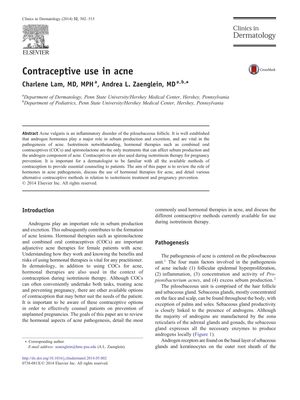Contraceptive Use in Acne
July 2014
in “
Clinics in Dermatology
”
hormonal therapies combined oral contraceptives COCs spironolactone androgens sebum production isotretinoin SHBG testosterone coronary artery disease venous thromboembolism long-acting reversible contraceptives LARC IUDs implants birth control pills Aldactone Accutane sex hormone-binding globulin heart disease blood clots long-term birth control intrauterine devices birth control implants

TLDR Hormonal contraceptives can help treat acne by affecting sebum production and androgen levels.
The document from July 1, 2014, reviews the role of hormones in acne development and the use of hormonal therapies, such as combined oral contraceptives (COCs) and spironolactone, in its treatment. Androgens are identified as key in sebum production and acne pathogenesis, with COCs and spironolactone being the only treatments affecting sebum production and the androgen component of acne. The paper emphasizes the importance of dermatologists understanding contraceptive methods, especially when prescribing isotretinoin due to its teratogenic risks. It reports that spironolactone is relatively safe during pregnancy, with a surveillance study of 229,101 pregnancies showing only two major defects in newborns exposed to it during the first trimester. Spironolactone's effectiveness in acne treatment is based on clinical judgment, with typical dosages ranging from 25 to 200 mg daily. COCs reduce androgen production and increase SHBG, decreasing circulating testosterone levels, with three FDA-approved COCs for acne treatment. The document also discusses the risks of COCs, such as coronary artery disease and venous thromboembolism, which are reduced with low-dose COCs. It highlights that COCs do not protect against STIs and that pelvic exams are no longer required before starting COCs. Drug interactions with COCs are addressed, noting that common acne antibiotics do not reduce contraceptive effectiveness, but some drugs can increase COC metabolism, risking contraceptive failure. The document concludes by advocating for the benefits of long-acting reversible contraceptives (LARC) methods like IUDs and implants, especially for adolescents and those on isotretinoin treatment.










